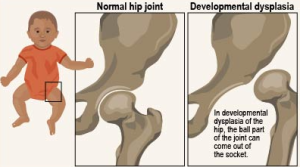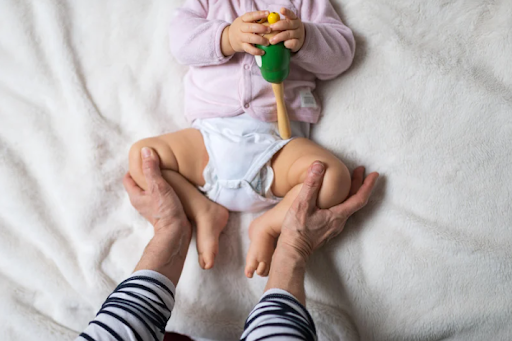June is International Hip Dysplasia Awareness Month, a perfect time to shed light on a condition that affects many newborns and infants: Developmental Dysplasia of the Hip, or DDH. As paediatric physiotherapists, we often work with families to help manage DDH, and we believe that early awareness and intervention are key to the best outcomes!
What is Developmental Dysplasia of the Hip (DDH)?
 DDH is a condition where the hip joint hasn’t formed correctly. In a healthy hip, the top of the thigh bone (femoral head) fits snugly into the socket of the pelvis (acetabulum). With DDH, this socket may be too shallow, or the femoral head may not be held firmly in place. This can range from the hip being slightly loose to the femoral head being completely dislocated from the socket.
DDH is a condition where the hip joint hasn’t formed correctly. In a healthy hip, the top of the thigh bone (femoral head) fits snugly into the socket of the pelvis (acetabulum). With DDH, this socket may be too shallow, or the femoral head may not be held firmly in place. This can range from the hip being slightly loose to the femoral head being completely dislocated from the socket.
It can affect one hip or both, and while it’s often present at birth, it can sometimes develop in the first few months or even years of life
The exact cause is not really known, although there are lots of known risk factors that increase the chance of your bub having DDH. These include:
- Female (4x more likely of having DDH)
- Breech positioning (10x more likely to have DDH)
- First baby (2x more likely)
- Large birth weight (2x >4kg)
- Family history
- Neuromuscular disorders
- poor swaddling technique
What causes DDH?
Signs to Look Out For
While some babies with DDH show no obvious signs, there are several things parents can look out for with their baby:
- Asymmetrical Thigh or Buttock Folds: When your baby is lying on their back, compare the skin folds on their thighs and buttocks. Uneven folds can sometimes indicate an issue with one hip.
- Reduced Movement or Flexibility in One Hip: You might notice your baby has less range of motion in one hip compared to the other, or they seem to favour one side.
- One Leg Appears Shorter: When your baby is lying on their back with knees bent and feet flat on the surface, one knee might appear lower than the other.
- Clicking or Clunking Sound in the Hip: While not always a sign of DDH, if you hear a consistent clicking or clunking from your baby’s hip during nappy changes, it’s worth getting checked.
- Difficulty with Nappy Changes: In some cases, a baby with DDH might resist having their legs spread out for a nappy change.
- Later Walking or Limping (in older children): If DDH is not detected early, older children may start walking later, or develop a limp.
It’s important to remember that these signs don’t definitively mean your child has DDH, but they do warrant a visit to your paediatric physiotherapist or GP for further assessment.
The Role of a Physiotherapist with Bubs with DDH
If your baby is diagnosed with DDH, a paediatric physiotherapist (most likely through your public hospital) often works in conjunction with an orthopaedic specialists to help with management of your baby. Here’s how:
- Bracing: For many babies, DDH is managed conservatively with a brace. As physiotherapists, we can help parents understand how to properly use and care for the harness, ensure it’s fitted correctly, and provide guidance on nappy changes, feeding, and positioning to ensure comfort and effectiveness.
- Promoting Gross Motor Development: While in a brace, it’s important to ensure your baby continues to meet their developmental milestones. We can provide strategies and exercises to encourage tummy time, head control, rolling, and other age-appropriate movements, adapting activities to work around the brace.
- Post-Brace Support: Once the brace is removed, we continue to support your child, ensuring they can achieve all their gross motor milestones confidently.
- Education and Empowerment: We empower parents with the knowledge and skills to confidently care for their baby with DDH, answering questions and addressing any concerns you may have throughout the journey.
If you are concerned about your child’s hips or their development overall, get in touch with one of our physiotherapists today!
Canobolas Kids Health
🏠 Address: 91 Dalton Street, Orange NSW 2800
📳 Phone: (02) 6360 2018
🌐Website: www.canobolaskidshealth.com.au



